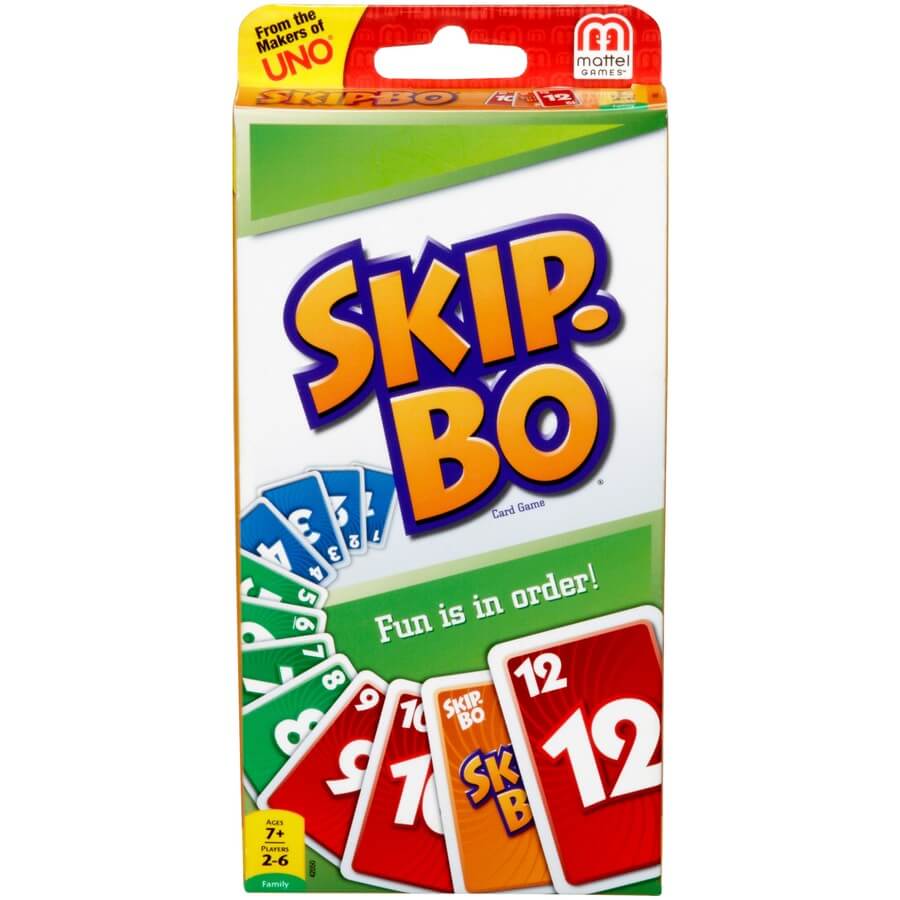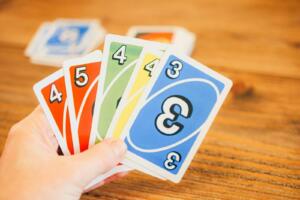Table of Contents
Skip Bo uses a custom deck made up of numbered cards and wilds. Each player gets a stack of cards they must work through, one by one, by building shared piles in the middle of the table. The rules take just a few minutes to learn, but each game feels different depending on the cards and the choices you make.

Introduction to Skip Bo rules
Skip Bo is a simple light-strategy card game from the makers of UNO. Two to six players race to play cards in order, using wild cards to shape the path. At its core, the game asks you to clear one personal stack before anyone else does. Turns move fast, and tension rises as the pile shrinks. Because the rules stay clear and the luck-skill mix feels fair, Skip Bo rules suit family nights, travel breaks, and friendly contests.
Setting up the game
Open the special Skip Bo deck. It holds 162 cards: twelve of each number 1 through 12 and eighteen Skip Bo wild cards. Shuffle the deck well. Next, you need to deal stock stockpiles. These are face-down stacks that each player must clear to win.
With two to four players, give each person 30 cards. With five or more, deal 20. Reveal only the top card of each stockpile. Put the rest of the deck in the middle as a shared draw pile. Leave space beside it for four building piles that will grow during play. Each player also keeps up to four personal discard piles, built face-up in front of them. Be sure to familiarize yourself with Skip Bo rules before you play.
You can play Skip Bo online, too, but follow the same layout. While doing so, remember the basics of protecting yourself online. Be sure to use secure logins and keep chats friendly.
Understanding the Objective
Your goal is to play every card from your stockpile before anyone else. You do not need to empty your hand or discard piles, though that helps. Each turn, the Skip Bo rules state that you should attempt to move the card from the top of your stockpile onto a building pile in the centre. But, because the piles are built from 1 to 12, you may need to lay groundwork first. Wild cards, smart discards, and careful timing all push you toward that final stock card.
The stockpile is the stack of cards placed in front of you, face down, with only the top card showing. You can’t sort it, move it, or look ahead. This adds a layer of challenge and surprise to the game. On your turn, you use cards from your hand or the discard piles to build the central piles and hopefully create space for your stock card.
Types of cards
Skip Bo uses only two kinds of cards, which keeps the rules light:
- Number cards 1–12: These must appear in exact order on each building pile. No suit or colour matters, only the number.
- Skip Bo cards: These wild cards can represent any number. On your turn you choose the value when you play it, and it stays fixed in the pile.
Skip Bo rules on building sequences
On your turn, draw up to five cards. If you start with fewer than five, the Skip Bo rules say you can draw until you reach five. Then play as many cards as you can, in any order: from your hand, from the top of your stockpile, or the tops of your discard piles.
- Building piles begin with 1 (or a Skip Bo used as 1) and grow upward to 12.
- When a pile reaches 12, remove it and start a fresh pile in that space.
- You may have up to four active building piles at once.
- You can play any number of cards during your turn as long as each play is legal.
- A Skip Bo wild card can stand in for any missing number and helps bridge gaps. Once placed, it acts like the chosen number.
- After your last desired play, end your turn by discarding one card face-up to any of your four personal discard piles. Arrange each pile in visible stacks so opponents can see its top card.
- The winner of a round gains an extra 25 points plus 5 points per card in opponents’ stockpiles.
Smart players watch not only their stockpile but also the open cards of others. Holding a key number can slow a rival. Dropping a useful card into your discard pile saves it for later. Yet if you hoard too long, you can clog your hand.
Winning the game
You win the hand the moment you place the last card from your stockpile onto a building pile. If you plan to track long matches, score the hand: add the leftover cards in every rival’s stockpile—five points each—to your tally.
Some groups play to 500 points, echoing classic UNO scoring, or the best-of-three hands. When a winner of a round is announced, be sure to give them a 25-point bonus according to the Skip Bo rules.
Keeping score isn’t required, but it can add structure to repeat games. When using the 500-point rule, each round contributes to your overall total. A well-timed win can give you a big boost if your opponents are stuck with thick stock piles. It also means you need to be aware of who’s getting close to that goal. If you’re playing with children or just want a quicker pace, you can skip scoring and enjoy each hand as its own game.
FAQs
What are the official Skip-Bo rules for setting up the game?
Shuffle the deck and deal each player a face-down stockpile—30 cards for two to four players, 20 cards for five or six players. Reveal only the top card. Place the remaining cards as a draw pile in the centre with space for four building piles and each player’s four discard piles.
According to Skip-Bo rules, how do you win the game?
You win when you play every card from your stockpile onto the shared building piles. Clearing that stack ends the hand at once, no matter how many cards remain elsewhere.
Are there any special Skip-Bo rules for two players?
Skip Bo rules do vary slightly for two players. In a two-player game, players deal 30 cards to each person instead of the 30 cards used for groups of five or six. This is the only tangible difference, though.



